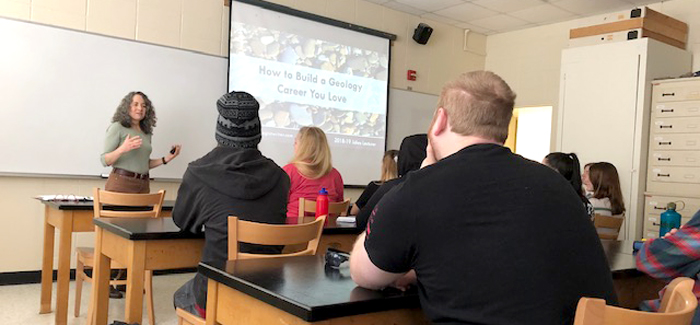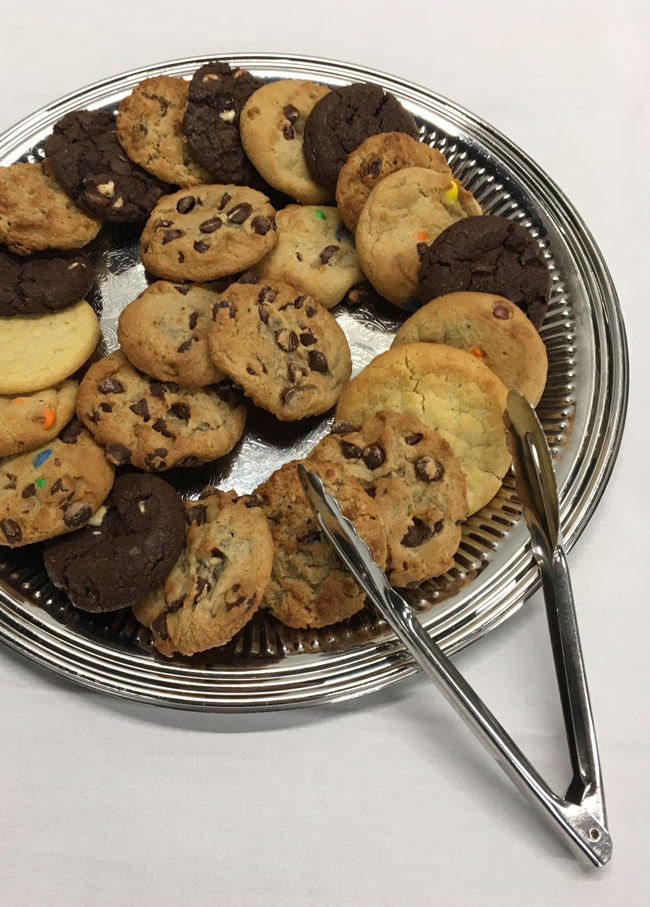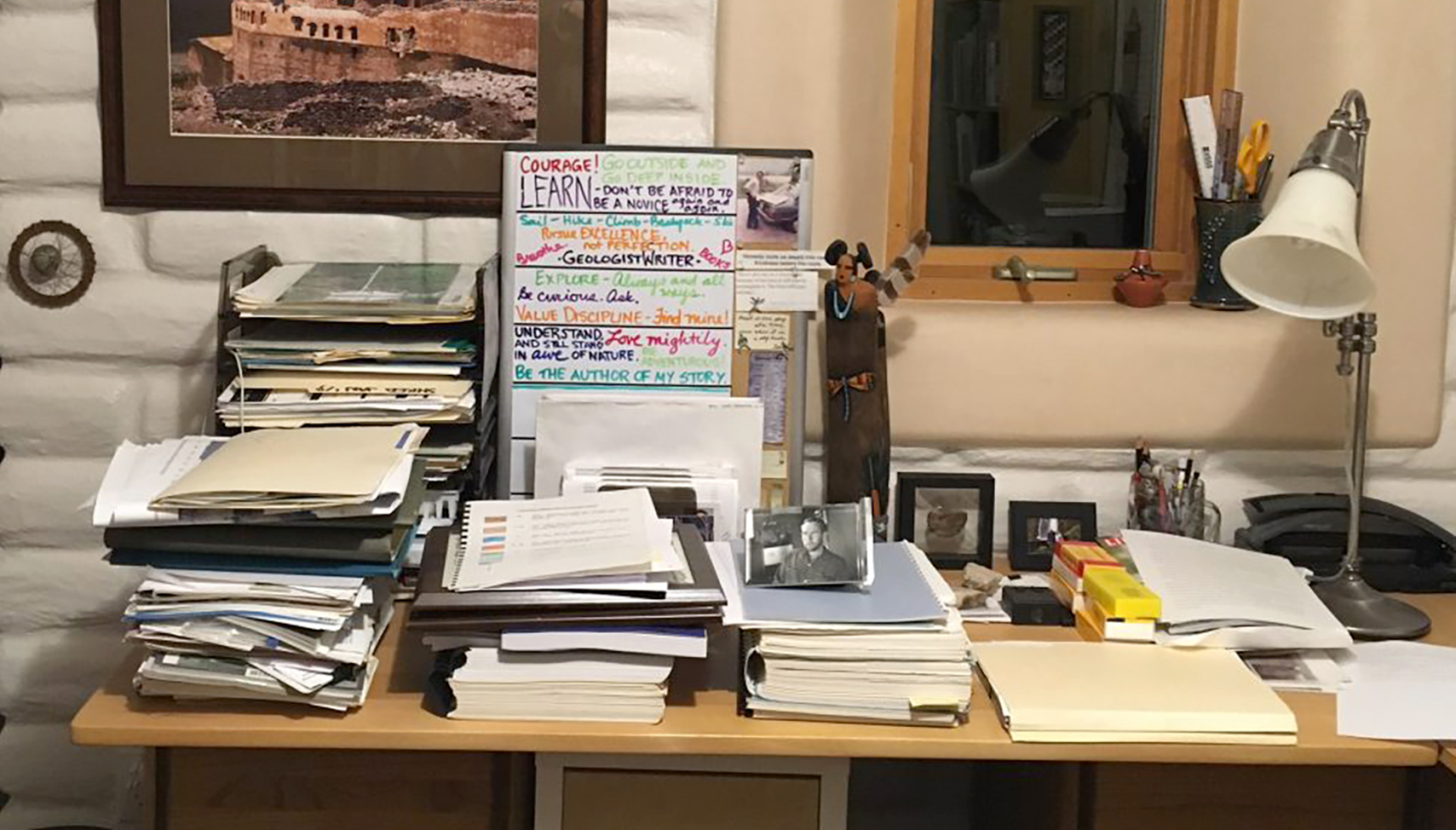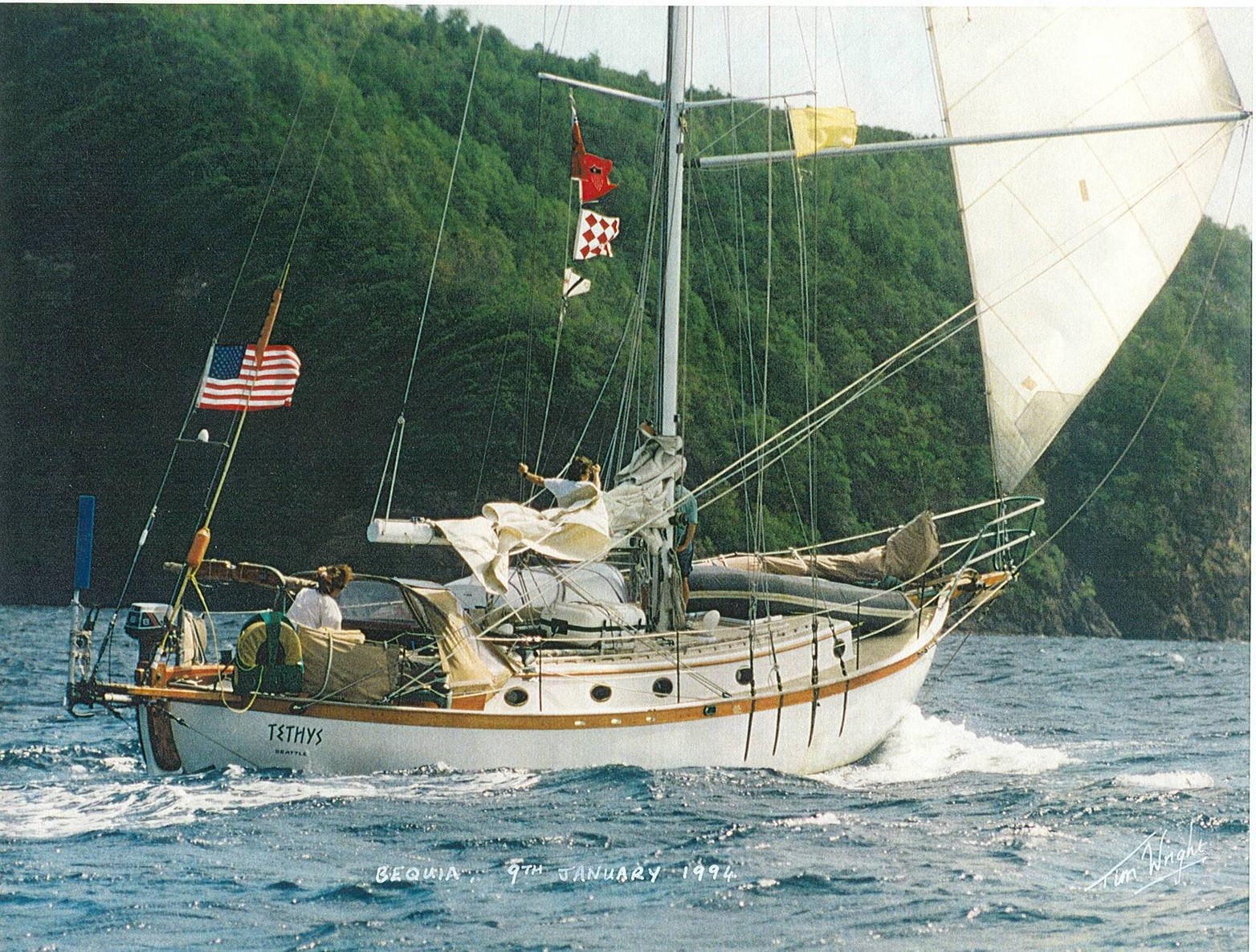
by D. J. Green | May 3, 2019 | Ground Work
My life as a professional geologist began the week before I turned 24, since then I’ve spent a significant portion of the last 35 years in the air, traveling for work and play. Whether in a two-seat tail-dragger or a 747, I always choose a window seat (yes, I know it’s not a choice in a two-seater, but you get my drift). On a recent outing, a Jahns Lecture visit to the University of Alaska’s Anchorage and Fairbanks campuses, I was thrilled by the truly breathtaking views of Denali (the High One in Athabaskan) while flying north. On the way home, another clear day provided equally amazing views of the mountains of Wrangell-St. Elias National Park, and the glaciers that carve them. To see the peaks and valleys, glaciers, and meandering and braided streams of Alaska’s dramatic landscape from an eagle-eye vantage point brings to mind things I’ve learned from the time my dad identified the rocks I picked up as a kid to my Geo 101 class as a college freshman to the lessons I’m still learning in the field today.
Perhaps the only thing better would be piloting the plane myself during those moments, choosing where to dip my wings and ride the winds. That is what engineering geologist, Will Ross, Inundation’s main character, relishes most. Read on to get a taste of what Will savors in those moments.
Turbulence jounced the plane and jolted Will’s attention back to the cockpit. He gripped the yoke and rode through the bumps. Leaving the wide floodplain of the Delaware River, he steered toward the peaks of the Poconos, the landscape rising beneath him. When he got to the Susquehanna River, he followed its green ribbon west-southwest. At the confluence of the North and West Branches of the Susquehanna, he left the river behind and headed for the heart of the Valley and Ridge.
Ridges of resistant rocks, sandstones, conglomerates, and limestones yielded to valleys underlain by soft shales, then climbed again on the harder rocks of the next ridge. The rock units spanned the land surface in parallel bands. Except where anticlines and synclines, geologic structures like the crests and troughs of ocean waves, angled into or out of the subsurface, there the units formed striking chevron patterns. To the right reader’s eye, those patterns told the story of Earth’s processes through the ages.
In Turkey, Will would read the story in the rocks. And in that story, he would find the answers they needed to make Kayakale Dam work.
Will looped among the lofty cumulus clouds. He leaned into turns and rolls, feeling the physics of flying in his muscles. His internal gyroscope engaged. Then he pulled into a stall. The stomach-dropping sensation of losing lift tested him. He stayed with it, fighting any hints of fear that rose in his throat. Satisfied he was under control, he pushed her nose down, gave her more throttle, and resumed his private air show by plummeting through another cloud break.
His neck relaxed and his jaw unclenched as he moved with the forces acting on the plane. Never against them. That’s what you do, he decided. Move with the forces acting on you.
Peering out the window to see the sights, yes, but it’s much more than that. Reading the landscape, and the story it has to tell, can change my whole outlook. It’s about perspective. Preparing the Jahns Lectures and gazing out the many airplane windows on my way to them, made me contemplate the work I’ve done over the decades as a professional geologist. It also helps me in moving ahead – reflecting on the horizon of my Jahns Lectureship, then looking forward to my second career as a writer (the Geologist Writer, of course) for which I’ve been laying a foundation for years as a student of the Earth, of the craft of writing, and of life.
In search of perspective? My answer is to book a window seat. Indeed, not doing so would be moving against the forces acting on me.
Window or Aisle? Literal or metaphorical? What’s your view? Why?


by D. J. Green | Mar 2, 2019 | Ground Work
Don’t Forget the Earplugs:
The man seated in 19F must be lonely. Hard to believe with the six kids he just told the passenger next to him (19E, it’s a full flight) he has. If he’s not lonely, how could he be so desperate to talk? And talk and talk and talk (and this comes from a bit of a talker, mind you).
We’ve been in the air an hour and 20 minutes, and 19F hasn’t stopped for breath. I’m annoyed, as the chatter is way too loud to fade to background noise, but also awed at this man’s seeming lack of need for oxygen.
Thankfully, there’s a tailwind, and we’ll be off this plane 30 minutes earlier than anticipated.
Note to self – Don’t leave home without earplugs ever again.
Always Book a Window Seat:
That’s the title of one of my Jahns Lectures, and what I always do. But this year, instead of simply enjoying the views of the landscape below, I find myself trying to take pictures too (something I do not always do). It’s not possible, at least for this very amateur photographer, to get great photos from an airplane window (though it must be amusing for my fellow passengers to watch the gyrations I’ll go through trying). I should, as they say, just “sit back, relax, and enjoy the flight,” and the views.

Reprise of the Recovering Perfectionist:
I woke up at 3:20 a.m. a few nights ago. Then I spent an hour thinking about ways to revise the PowerPoints for my Jahns Lectures. Cool ideas, that would take me hours (I’m not great at working in PowerPoint). Hours over the many I’ve already put into composing and tweaking the talks.
Would these changes make the talks better? Yes, I think they would. Enough to invest the time? No, I think not.
.
Besides, would it be for the students I’m speaking with, or to satisfy this perfectionist who still, apparently, has not quite recovered. Perhaps focusing on authentic communication with and genuine caring for my listeners is the best way to spend my time and energy. Hmmm, food for thought.
And speaking of food…
Step Away from the Cookie:
I love cookies. Especially chewy chocolate chip cookies. You know, the kind you can really taste the butter in. With dark chocolate chips, of course.
Unfortunately, each of those cookies contains as many calories as I can consume in a whole day without having to purchase a new, larger-sized wardrobe.
Seems like every Jahns Lecture visit is accompanied by a platter of these delights. Or hot, melty pizza. Sigh.
I admit the occasional vegetable tray and fruit plate have been offered, but they’re somehow rendered invisible when placed next to the aforementioned sweet and savory temptations.
So, I must step away from the cookie. Well, most of them…after all, nobody’s perfect.
Thanks to all who are helping to make my year as the Richard H. Jahns Lecturer in Applied Geology a fulfilling experience and great adventure. Coming soon to a college or university near you!

by D. J. Green | Dec 14, 2018 | Ground Work
This post is related to the last one I wrote, more than two months ago now. It was about procrastination. Sure, I’ve been busy. Who isn’t? It went something like this: Finding the Words? I’ll Look for Them Later…. And that was about it.
If I go looking for the perfect words, then I might as well put it off. Indefinitely. I’ll never find them. I will also never be in perfect shape. Kagán is not a perfectly shiny boat. I do not have a tidily perfect library to write in. Most days, I don’t even come close to crossing everything off my list of things to do, which in a perfect world I would. Every day.
Perfection is unattainable. Pursuing it, I’ll fail every time. Procrastination is a reasonable response to seeking it; why push for ultimate failure? The problem is that not only do things not get done perfectly, they don’t get done at all. I know all this intellectually. But clearing the hurdle I set up for myself, in order to pursue excellence rather than perfection, well, that’s another matter.
I’ve been this way as long as I can remember being any way at all. I was the goodie-two-shoes of my family from the time I stepped into my first pair of shoes. And I wore out pair after pair chasing perfection; as a kid, to please my parents, which I did (so I was amply rewarded for the chase). And as an adult, to please myself. Except I’m never pleased enough. And this chase is awfully tiring.
.
When I reflect on this in a deep way, I must admit that the perfectionist part of me thinks completely unreasonable things. Like I could have kept my sweet old dog, Sandy, from dying last month if I’d been a better dog mom. Even though Sandy lived well over 15 years, overcoming laryngeal paralysis, thriving because of how well cared for and loved he was. He was happily, if wobbily, walking in the desert with me just days before his system shut down and he passed peacefully at home. Can I really think that wasn’t good enough? Can I not simply be grateful for how long and healthy and happy his life was?
Here’s one that’s even harder to admit, front and center in my heart, mind, and memory these days. Twenty-one years ago yesterday, my late husband’s plane, with his body beside it, was found in the Texas hill country after a month-long search. For years, I struggled, not only with the depth of my loss, but with a belief that if I’d somehow been a better wife that he would not have died in that accident.
.
Not only do those thoughts not make sense (the convoluted logic being if I was perfect, I’d be completely in control, not only of myself, but of others and every situation), frankly, they’re absurd, and incredibly egotistical.
So, I continue to steer myself away from the dead-end path of perfectionism. My step for today – to post this essay, though it is far from perfect (for one thing, there are way too many adverbs in it). But maybe, just maybe, letting go of trying to be in control of it all, whether it’s the right word choice or comma placement, or letting those I love live, and die, as they must, will be exactly what I need to live into and learn from today. And every day.
What are your hardest lessons?

by D. J. Green | Oct 2, 2018 | Finding the Words
I was going to write a post about procrastination today, but I decided to put it off.
.
.
.

by D. J. Green | Sep 4, 2018 | Venus & Mars Go Sailing
She can change your life. For me, that teacher’s name is Nancy Erley.
The first time I met her was brief, just a short exchange after hearing her insightful presentation on crew communication at a sailing expo. But I never forgot her.
The next time I met her was years later. I was grieving the loss of the man I’d sailed with for eight years, and though I wanted very much to continue cruising on Kagán, I wondered if I could even maneuver her into my narrow slip, much less sail her on my own. Then Nancy spent a week with me on Kagán, and she changed my life – on my boat, certainly, and in ways I couldn’t have imagined before I lived into taking Kagán’s helm. During that week, she watched me, asked questions about the role I had played as first mate, and gently suggested that if I’d done things like set sails in gusty winds and set anchors in deep, remote anchorages with Jerry, then I could do those things, with sensible adjustments for single handing, on my own.
She knew a little something about all this, a passionate sailor, Nancy has completed two circumnavigations on her boat, Tethys. During those trips around the globe, she taught women how to cross oceans in a small boat, as they did it together. Her gift for imparting the skills and the wonder of both the physics and the art of sailing, tailored to fit each of her “learners,” has changed lives, made dreams come true. This is not hyperbole, it’s what Nancy does.
.
First, we would talk through the whats and hows, and then she would assure me she’d be right there if I needed her, but I should try these things as if I was single handing. From seemingly casual conversations, she intuited what I felt I could already do, and what might stop me. She nudged me toward those lessons. Her confidence and the reassurance of her presence gave me the courage to try. And to keep trying after our week together, even though I was still afraid (especially of maneuvering under power in tight spaces with my full keel boat that doesn’t like to start turning and once she turns doesn’t like to stop). Nancy encouraged me to let go of the fear, which for sailing solo I could. It took longer, years in fact, to let go of the fear of going into new marinas, having to maneuver in unknown tight spaces. Sometimes I succeeded (nailing a tough landing feels great) and sometimes I failed (seems your ugliest landings always happen with an audience on the dock), but I never stopped trying. And that’s the key – if you keep docking, you learn how to dock in different places in varying conditions. Then one day, you realize that now you have a great deal of respect for every docking (really, there’s a lot going on when you dock a boat, but that’s another story), but not so much trepidation. That “you become what you practice” thing – it worked again.
The lessons continue, occasionally in person (thanks for those great days on Port Townsend Bay earlier this summer, Nancy!), and more frequently on my own, not only using the skills she’s taught me, but also trying to emulate the examples she’s set for me to be the skipper I aspire to be. That’s what a gifted teacher can do.
Tell me about your Nancy Erley. How has he or she changed your life?













Recent Comments